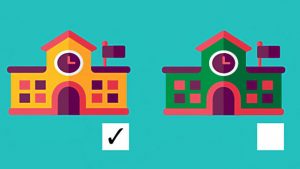Home » Commentary » Opinion » Choice means more than a public-private pick
· Ideas@TheCentre

 The Australian Scholarships Group (ASG)’s flagship annual publication — the Parents Report Card — dishes up some choice findings about school choice in Australia. It provides a sober account of what matters to parents and dispels the claims of school choice opponents.
The Australian Scholarships Group (ASG)’s flagship annual publication — the Parents Report Card — dishes up some choice findings about school choice in Australia. It provides a sober account of what matters to parents and dispels the claims of school choice opponents.
For detractors, choice in schooling is scorned as synonymous with educational ‘segregation; into gated school communities. They argue choice is a luxury enjoyed by the rich, while the rest are ‘stuck’ with their local school.
But choice is about more than those who can afford to fork out for private school. Parents in NSW enjoy more options than in other states — for instance, with more selective schools and specialist performing arts and sports schools, all under the public school tent. But when it comes to choice, more is more.
And choice in public schools is now threatened by the crackdown on the number of out-of-area enrolments permitted in NSW. This makes it harder for parents to send children to schools on their way to work, or to where their siblings go, or where their needs are best served.
To be sure, for some parents, choice is a non-starter. And, by all means, parents are free to choose not to choose. But, most parents — and increasingly, their children — value choice and don’t take it lightly.
Many already opt for private school. Over 40% of students in high school and 31% in primary attend a non-government school. Enrolment growth in independent schools, in particular, has been outpacing that of public schools.
A lot goes into the process, but the top considerations according to the ASG are a prospective schools’ reputation, sector, and performance. ABS data shows that for those at private school, reputation is by far the primary reason for choosing a school. For those at public schools, being close to home is the decisive factor.
ASG emphasises that ‘choosing a school with confidence’ is about finding the ‘right’ school, not necessarily the so-called ‘best’ school. This reflects that school reputations are formed by more than scouting the MySchool website — though the tool certainly doesn’t hurt.
For many, choosing a school is also not a decision hatched overnight. 42% considered their high school before commencing primary school — including 61% of those in independent schools, though only 33% in public schools. Another study found one in four consider schools from the time of a child’s birth.
It’s true that choice is not enjoyed equally and fully by everyone. The main barriers reported are cost, waiting lists, and zoning — with barriers more commonly reported by parents of children in public schools.
Cost of some schools is prohibitive for many parents; more than two-thirds report feeling the pinch financially. More efforts to make private school affordable can relieve some of this pressure and make it a viable option.
Waiting lists are tough to nudge, but it pays to remember that they are an indication of demand. One way waiting lists could be reduced is for there to be a greater supply of desirable schools.
The zoning of school catchments compels students of public schools to go local – even if they would prefer to go out-of-area. Zoning also means the composition of schools is less diverse than they would be otherwise – since local areas tend to share demographics. Zoning hurts those living in disadvantaged areas the most — forcing them to pick between public and private, rather than weighing up diverse school offers.
OECD research has argued that to deliver on its promise, choice must be ‘real, relevant, and meaningful’. In Australia, choice needs to be more than just a public-private pick.
Choice means more than a public-private pick